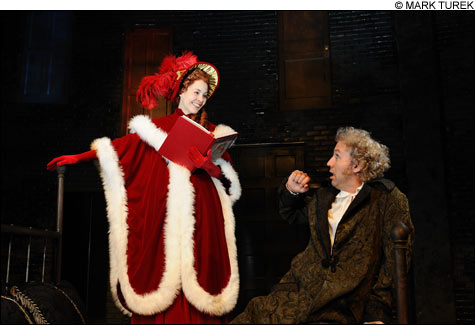
HO HO HO! Rachael Warren and Mauro Hantman in A Christmas Carol. |
There are more than 30 different productions of Charles Dickens's A Christmas Carol being performed at hundreds of theaters around the country, usually in clone versions as identical as re-screened films. Familiarity breeds big box office.
Trinity Repertory Company's production is distinctive. It uses the same script, the adaptation by Trinity founder Adrian Hall and composer Richard Cumming, but each year a director is handed the challenge of presenting a fresh version to audiences.
Through December 31, theatergoers will see what this year's directorial adventurer, Michael Perlman, comes up with in Trinity's 34th annual staging.
Perlman, a graduate earlier this year of the Brown/Trinity Rep MFA program, has a clear idea of where he wants to take us in his Christmas Carol.
"I think the heart of the story is Scrooge realizing that he has the ability to change and the desire to change," he says. "Not just the ability to change himself but the ability to change the world."
His initial notion was to focus on the sense of community that Scrooge lacked and what it meant for him to rejoin the community of humanity as well as that of London. "The thing he is confronting in the future is being alone," Perlman points out. But while he had seen other adaptations, as well as Trinity's for the past three years, when he reread the Dickens novella one passage in particular struck him: when the old curmudgeon is reminded that as a boy he had love in his heart, for his sister Fan.
"He's remembering the person he loved," Perlman says. "In a book it's easy to get inside someone's head, and I think [Dickens] does that so beautifully. He helps connect the dots about why Scrooge wants to change. And also why he is the way he is."
Mauro Hantman, this year's Scrooge, had strong opinions about how the character should come across, the director recalls. "Before I said anything, Mauro said, 'I think Scrooge needs to be huge. I don't think that he just cuts himself off from people, he pushes people away. He needs to be actively pushing people away.' And I couldn't have agreed more."
Since Scrooge's emotional journey would be especially important, Perlman knew that he'd have to spend a lot of time on "the soundscape of the world" with the musical director, Michael Rice.
Another aid to helping the audience get into Scrooge's head is the set design by Patrick Lynch. "It's a slightly more psychological space than usual," the director notes. "It's evocative of 18th-century London. There are elements of realism, but the space is more a psychological space."
More than a dozen doors, some dangling above the audience, serve as portals into different moments of Scrooge's experience. "Also with Stave Four, the future," he continues, "the world serves as the ghost and there's no Grim Reaper figure." Instead of the traditional, mute, black-hooded spirit pointing to events, lighting by designer John Eckert will show Scrooge where to look.